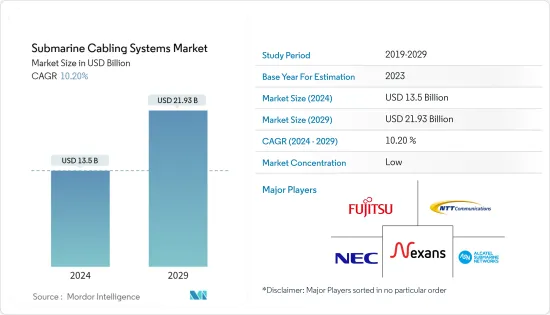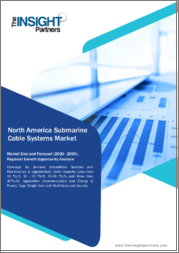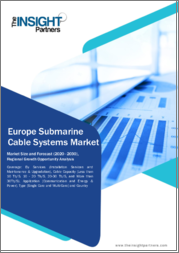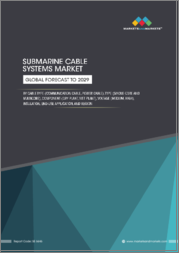
|
시장보고서
상품코드
1441570
해저 케이블 시스템 : 시장 점유율 분석, 업계 동향 및 통계, 성장 예측(2024-2029년)Submarine Cabling Systems - Market Share Analysis, Industry Trends & Statistics, Growth Forecasts (2024 - 2029) |
||||||
해저 케이블 시스템 시장 규모는 2024년 135억 달러로 추정되고, 2029년까지 219억 3,000만 달러에 이를 것으로 예측되며, 예측기간(2024-2029년) 동안 10.20%의 연평균 복합 성장률(CAGR)로 성장할 전망입니다.

주요 하이라이트
- 해저 케이블 시스템은 일반적으로 데이터와 전력 전송 모두에 광섬유 케이블을 사용합니다. 이 시스템은 해저에 놓여 있으며 다양한 장소에 있는 케이블 육상국(CLS)을 연결하여 광대한 해양에 통신과 전력 신호를 전송합니다. 해저 케이블 시스템은 세계 국가간에 안정적이고 안전하며 대용량 통신 링크를 제공합니다.
- 해저 케이블 시스템 시장의 성장을 가속하는 주요 요인 중 하나는 고속 인터넷 인프라에 대한 투자 증가입니다. 게다가 세계 데이터 생성과 전송의 지속적인 확대는 시장 성장을 크게 촉진할 것으로 예상됩니다. 그 결과 다수의 인터넷 백본 사업자가 예측 기간을 통해 해저 케이블 시스템 시장에 투자할 것으로 예상됩니다.
- 인터넷 액세스가 신흥 국가에서 확대됨에 따라 네트워크 개선의 다음 단계는 세계 신흥 시장에 초점을 맞출 수 있습니다. 그 결과 정부 기관을 포함한 많은 기업들은 해저 케이블 시스템 시장을 유리한 전망으로 인식하고 있습니다. 또한 모바일 광대역 도입의 급속한 증가는 업계 성장에 크게 기여하고 있습니다.
- 또한 가처분 소득 증가, 5G 도입, 통신 인프라 진보 등 다양한 요인으로 인해 스마트폰 수요가 세계적으로 증가하고 있습니다. 에릭슨의 보고에 따르면 세계 스마트폰 가입자 수는 2021년 62억 6,000만 명으로, 2027년에는 76억 9,000만 명에 달할 것으로 예상됩니다. 이러한 추세는 계속 조사 대상 시장 성장의 주요 추진력이 될 것으로 예상됩니다.
- 세계 경제와 통신에 있어 매우 중요한 해저 케이블은 국가에 의한 방해 행위나 스파이 행위 등 지정학적, 물리적, 사이버 위협에 점점 노출되는 환경에서 운용되고 있습니다. 공식 정보 근거에 따르면 해저 통신 케이블은 사이버 공격자에게 점점 더 표적이 되고 있으며, 사건이 발생하면 세계적으로 인터넷에 심각한 혼란을 일으킬 수 있으며 조사 대상 시장의 성장에 더욱 영향을 줄 수 있습니다.
- COVID-19 기간 동안 봉쇄로 인해 상당한 수의 주택 소유자가 비접촉식 청소 및 노인 가족의 가정 간호를 위해 자율 로봇과 같은 고급 전자 장비를 도입하기 시작하였고, 그 후 인터넷 소비가 증가했습니다. 또한 팬데믹은 보다 광범위한 사람들의 소비 패턴에 큰 변화를 가져왔고, 사람들이 그 어느 때보다 새로운 기술에 대해 개방되었습니다. 이러한 변화는 포스트 코로나 기간 동안 해저 케이블 네트워크에 대한 투자를 촉진할 것으로 예상됩니다.
해저 케이블 시스템 시장 동향
시장 성장을 견인하는 건식 플랜트 제품
- 건식 플랜트는 해변의 맨홀에서 케이블 착륙장까지 연장되는 육상 해저 케이블 네트워크 부문으로 구성됩니다. 여기에는 급전 장치(PFE), 해저 회선 종단 장치, 네트워크 관리 시스템, 육상 케이블 부문이 포함됩니다.
- 광대역 서비스와 네트워크 성능 향상에 대한 고객 수요에 부응하여 전 세계 통신 트래픽이 급속히 확대되고 있습니다. 예를 들어 ITU에 따르면 주민 100명당 고정 광대역 계약 수는 2022년 유럽에서 35.4건, 아메리카에서는 25.4건이었습니다. 그 결과 해저 통신 시스템 수요는 새로운 케이블 시스템의 구축뿐만 아니라 기존의 케이블 시스템의 용량을 증대시키기 위해서도 꾸준히 증가하고 있습니다. 일부 기업들은 이러한 수요 증가에 부응하기 위해 광 기술을 활용한 해저 회선 단말 장치(SLTE)를 개발하고 있습니다.
- 예를 들어 2023년 10월에는 Google Equiano 케이블의 세인트 헬레나 지선이 개통되어 고속 해저 광섬유 케이블을 통한 섬의 인터넷에 대한 첫 연결을 나타냈습니다. 2023년 6월까지 케이블 해저선 단말기의 설치와 통합이 완료되었으며, 로컬 지상 광섬유 네트워크의 건설이 시작되었습니다.
- 육상 케이블 부문은 해저선 터미널과 케이블 육상 스테이션의 전원 공급 장비 및 기타 시스템을 연결합니다. 네트워크 관리 시스템은 해저 케이블 시스템의 모든 장비를 관리하는 통합 플랫폼으로 작동하며 일상적인 유지 보수 및 운영 중 습식 플랜트, 전원 공급 장치(PFE), 오픈 케이블 액세스 장비(OCAE) 및 네트워크 운영 감시합니다.
- 건식 플랜트 제품은 일반적으로 강한 바람, 소금물 분무, 극한 온도와 같은 가혹한 해안 환경 조건을 견딜 수 있도록 설계되었습니다. 건식 플랜트에 장애가 발생하면 전체 해저 케이블 시스템의 서비스 중단으로 이어질 수 있으므로 설계는 높은 신뢰성을 선호합니다.
환태평양이 큰 시장 점유율을 차지합니다.
- 태평양 지역에서는 1960년대에 최초의 태평양 횡단 해저 케이블 시스템(TPC-1(Trans-Pacific Cable 1))이 운영되었습니다. 이것은 일본, 괌, 하와이, 하와이를 통해 미국 본토를 연결하는 128 회선이라는 겸손한 회선 용량으로 시작한 해저 동축 케이블이었습니다. 그 이후로 수많은 태평양 횡단 해저 케이블 시스템이 지속적으로 건설되었으며, 이 지역의 용량은 크게 확대되었습니다.
- 해저 케이블은 세계 인터넷 트래픽의 97% 이상을 처리하고 있으며, 이는 일상 업무에서 인터넷에 대한 의존도의 넓이를 반영하고 있습니다. 세계 사람들을 연결하는 인터넷 기능으로 국제 트래픽이 계속 증가하고 있습니다. 아시아태평양은 세계 인터넷 트래픽의 약 절반을 차지하고 있으며 해저 통신 케이블 수요를 촉진하고 있습니다. 이 지역의 특정 국가에서는 이러한 시스템이 부족하기 때문에 태평양 지역에서는 더 빠른 인터넷 서비스에 대한 필요성이 증가하고 있으며 세계 은행 및 아시아 개발 은행과 같은 조직에서 새로운 케이블 시스템에 대한 자금 제공이 촉구되었습니다.
- NTT Ltd Japan Corporation, Mitsui & Co. Ltd, PC Landing Corp., and JA Mitsui Leasing, Ltd는 2022년 7월에 「JUNO」의 구축 및 운영을 목적으로 한 신회사 '세렌주노 네트워크(이하, 셀레늄) '의 설립을 발표했습니다.
- 또한 2022년 8월 NEC Corporation는 미국 미국과 일본의 치바현과 미에현을 연결하는 태평양 횡단 해저 광섬유 케이블 'JUNO 케이블 시스템'의 건설에 셀렌 주노 네트워크 사를 선정한 것을 밝혔습니다. 이 케이블은 총 길이 10,000km를 넘어 2024년까지 완성될 예정입니다.
- 특히 일본과 호주를 포함한 이 지역의 주요 국가는 해저 케이블 시스템이 자국의 경제 성장에 필수적이라고 생각하고 있으며, 해저 케이블 네트워크에 대한 투자를 강화하고 있으며 조사 대상 시장에 기회를 창출하고 있습니다. 예를 들어, 2023년 7월 일본 정부는 일본과 세계 기타 지역 해저 케이블 네트워크를 확장하기 위해 디지털 인프라 개발 기금을 강화할 계획을 발표했습니다.
해저 케이블 시스템 산업 개요
해저 케이블 시스템 시장에는 NTT Communications Corporation, Nexans SA, Fujitsu Ltd, NEC Corporation, and Alcatel Submarine Networks 등 다양한 주요 기업이 참여하고 있습니다. 이러한 기업들은 수익 성장을 가속하고 세계의 존재를 확대하기 위해 공동 사업, 장기적인 파트너십, 합병 및 인수와 같은 전략적 노력을 추진하고 있습니다.
2023년 10월 NEC는 인도네시아에서 Patara-2 해저 케이블 네트워크의 완성과 가동을 시작했습니다. 이 네트워크는 국내 최대의 디지털 통신 제공업체인 PT Telkom 인도네시아가 소유하고 있으며, 인도네시아의 다양한 섬들에서 디지털화 노력을 진행하는데 있어서 매우 중요한 단계가 되고 있습니다.
마찬가지로 Google LLC는 같은 달에 South Pacific Connect 이니셔티브 계획을 발표했습니다. 이 구상은 호노모아나와 타브아라는 두 개의 새로운 태평양 횡단 해저 케이블의 도입을 수반합니다. 이 케이블은 태평양 지역 전체의 디지털 연결의 신뢰성과 탄력성을 크게 향상시키는 것을 목표로 합니다.
기타 혜택
- 엑셀 형식 시장 예측(ME) 시트
- 3개월의 애널리스트 서포트
목차
제1장 서론
- 조사의 전제 조건 및 시장의 정의
- 조사 범위
제2장 조사 방법
제3장 주요 요약
제4장 시장 인사이트
- 시장 개요
- 업계의 매력-Porter's Five Forces 분석
- 구매자의 협상력
- 공급기업의 협상력
- 신규 참가업체의 위협
- 대체 제품의 위협
- 경쟁도
- 업계의 밸류체인 분석
- 매크로 동향이 업계에 미치는 영향
제5장 시장 역학
- 시장 성장 촉진요인
- 컨텐츠 제공업체로부터 인터넷 대역폭 수요 증가
- 신흥 지역의 해저 케이블 연결 증가
- 해상 풍력 발전에 대한 투자 확대
- 시장 성장 억제요인
- 데이터 프라이버시 및 현지화에 대한 노력
- 지정학적 긴장에 의해 프로젝트가 제한됩니다.
제6장 시장 세분화
- 유형별
- 건식 플랜트 제품
- 습식 플랜트 제품
- 소유 유형별
- 복수 소유 제도
- 싱글 오너십 시스템
- 국제개발 금융기관
- 지역별
- 태평양 횡단
- 대서양 횡단
- 미국-라틴아메리카
- 아시아내
- 유럽-아시아
- 유럽-사하라 이남의 아프리카
제7장 경쟁 구도
- 기업 프로파일
- Alcatel Submarine Networks
- NEC Corporation
- Nexans SA
- Fujitsu Ltd
- NTT Communications Corporation
- Google LLC
- SubCom LLC
- Sumitomo Electronics Industries Ltd
- JDR Cable Systems LLC
- PT Communication Cable System Indonesia Tbk
제8장 투자 분석
제9장 시장 전망
AJY 24.03.15The Submarine Cabling Systems Market size is estimated at USD 13.5 billion in 2024, and is expected to reach USD 21.93 billion by 2029, growing at a CAGR of 10.20% during the forecast period (2024-2029).

Key Highlights
- Submarine cable systems typically utilize optical fiber cables for transmitting both data and power. These systems are laid on the seabed, connecting cable landing stations (CLS) at different locations to carry telecommunication and power signals across vast expanses of the ocean. Submarine cabling systems offer highly reliable, secure, and high-capacity telecommunication links between countries worldwide.
- One primary factor driving the growth of the submarine cabling system market is the increased investment in high-speed internet infrastructure. Additionally, the continuous expansion in data generation and transmission globally is anticipated to significantly boost market growth. Consequently, numerous internet backbone operators are expected to invest in the submarine cabling system market throughout the forecast period.
- As Internet access expands in developing countries, the next phase of network improvement may focus on emerging markets worldwide. Consequently, many businesses, including government entities, perceive the submarine cabling system market as a lucrative prospect. Moreover, the rapid increase in mobile broadband adoption significantly contributes to industry growth.
- Furthermore, the global demand for smartphones has been on the rise due to various factors, including increasing disposable income, the introduction of 5G, and telecom infrastructure advancements. Ericsson reports that the global number of smartphone subscribers was 6.26 billion in 2021, predicted to reach 7.69 billion in 2027. These trends are expected to remain key drivers of the studied market's growth.
- Submarine cables, crucial to the global economy and telecommunications, operate in an environment increasingly exposed to geopolitical, physical, and cyber threats, including nation-state sabotage and spying. According to official sources, submarine communication cables are a growing target for cyber-threat actors, with incidents capable of causing substantial global internet disruption, further impacting the studied market's growth.
- During the COVID-19 period, a significant number of homeowners began implementing advanced electronic devices, such as autonomous robots, for contact-free cleaning and home care of elderly family members due to lockdowns, subsequently increasing internet consumption. The pandemic also led to a significant change in consumption patterns among broader populations, making them more open than ever to new technologies. This shift is expected to drive investments in the subsea cable network in the post-COVID period.
Submarine Cabling Systems Market Trends
Dry Plant Products to Drive the Market's Growth
- The dry plant comprises the subsea cable network segment on land, extending from the beach manhole to the cable landing station. This encompasses power feeding equipment (PFE), submarine line terminal equipment, network management systems, and land cable segments.
- Global telecommunications traffic is rapidly expanding in response to customer demands for broadband services and enhanced network performance. For instance, according to ITU, the number of fixed broadband subscriptions per 100 inhabitants was 35.4 in Europe in 2022 and 25.4 in the Americas. Consequently, the demand for submarine telecommunication systems is steadily increasing, not only for constructing new cable systems but also for augmenting the capacity of existing ones. Several companies are developing Submarine Line Terminal Equipment (SLTE) utilizing optical technologies to meet this rising demand.
- For instance, in October 2023, the Saint Helena branch of the Google Equiano cable was activated, representing the island's inaugural connection to the internet through high-speed subsea fiber optic cables. By June 2023, the installation and integration of the cable's Submarine Line Terminal Equipment had concluded, prompting the commencement of work on the local terrestrial fiber optic network.
- The land cable segments link the submarine line terminals to the power-feeding equipment and other systems at the cable landing station. The Network Management System serves as the unified platform managing all equipment in the submarine cable system, overseeing the wet plant, Power Feeding Equipment (PFE), Open Cable Access Equipment (OCAE), and network operations during routine maintenance and operation.
- Dry plant products are typically engineered to withstand harsh coastal environmental conditions, including high winds, salt spray, and extreme temperatures. Their design prioritizes high reliability, as any disruption to the dry plant can result in a service outage for the entire submarine cable system.
Trans-Pacific to Hold a Significant Market Share
- In the transpacific region, the first Trans-Pacific submarine cable system (TPC-1 (Trans-Pacific Cable 1)) operated during the 1960s. It was a submarine coaxial cable that began with a modest 128-phone line capacity, linking Japan, Guam, Hawaii, and the mainland United States via Hawaii. Since then, numerous transpacific submarine cable systems have continuously been constructed, significantly expanding the region's capacity.
- Submarine cables handle over 97% of global Internet traffic, reflecting the widespread reliance on the Internet for daily tasks. The Internet's capability to connect people globally has led to a continuous rise in international traffic. The Asia Pacific region contributes approximately half of the world's internet traffic, driving the demand for submarine communication cables. The lack of these systems in certain countries within this region has spurred the need for faster internet services in the Transpacific region, prompting funding from organizations like the World Bank and the Asia Development Bank for new cable systems.
- In July 2022, NTT Ltd Japan Corporation, Mitsui & Co. Ltd, PC Landing Corp., and JA Mitsui Leasing, Ltd. announced the formation of a new company, Seren Juno Network Co., Ltd. ("Seren"), established to construct and operate "JUNO," the most extensive trans-Pacific submarine cable system linking Japan and the United States.
- Moreover, in August 2022, NEC Corporation revealed that Seren Juno Network had selected them to build the trans-Pacific subsea fiber-optic cable, the "JUNO Cable System," connecting California in the United States with Chiba and Mie prefectures in Japan. This cable, spanning over 10,000 km, is projected to be completed by 2024.
- Key countries in the region, including Japan and Australia, among others, consider submarine cabling systems vital for their economic growth and are intensifying their investments in submarine cable networks, creating opportunities in the studied market. For instance, in July 2023, the Japanese government unveiled plans to augment the Digital Infrastructure Development Fund to expand the submarine cable networks linking Japan with the rest of the world.
Submarine Cabling Systems Industry Overview
The submarine cable systems market features various key players, including NTT Communications Corporation, Nexans SA, Fujitsu Ltd, NEC Corporation, and Alcatel Submarine Networks. These companies engage in collaborative ventures, long-term partnerships, and strategic initiatives like mergers and acquisitions to bolster revenue growth and expand their global presence.
In October 2023, NEC Corporation marked the completion and activation of the Patara-2 submarine cable network in Indonesia. This network, owned by PT Telkom Indonesia, the country's largest digital telecommunications provider, stands as a pivotal step in advancing digitization efforts across Indonesia's diverse islands.
Similarly, Google LLC revealed plans for the South Pacific Connect initiative during the same month. This initiative entails the implementation of two new transpacific subsea cables-Honomoana and Tabua. These cables aim to significantly enhance the reliability and resilience of digital connectivity across the Pacific region.
Additional Benefits:
- The market estimate (ME) sheet in Excel format
- 3 months of analyst support
TABLE OF CONTENTS
1 INTRODUCTION
- 1.1 Study Assumptions and Market Definition
- 1.2 Scope of the Study
2 RESEARCH METHODOLOGY
3 EXECUTIVE SUMMARY
4 MARKET INSIGHTS
- 4.1 Market Overview
- 4.2 Industry Attractiveness - Porter's Five Forces Analysis
- 4.2.1 Bargaining Power of Buyers
- 4.2.2 Bargaining Power of Suppliers
- 4.2.3 Threat of New Entrants
- 4.2.4 Threat of Substitute Products
- 4.2.5 Degree of Competition
- 4.3 Industry Value Chain Analysis
- 4.4 Impact of Macro-trends on the Industry
5 MARKET DYNAMICS
- 5.1 Market Drivers
- 5.1.1 Increasing Demand for Internet Bandwidth from Content Providers
- 5.1.2 Increasing Submarine Cable Connectivity in Emerging Regions
- 5.1.3 Growing Investments in Offshore Wind Farms
- 5.2 Market Restraints
- 5.2.1 Data Privacy and Localization Initiatives
- 5.2.2 Geopolitical Tensions Limiting Projects
6 MARKET SEGMENTATION
- 6.1 By Type
- 6.1.1 Dry Plant Products
- 6.1.2 Wet Plant Products
- 6.2 By Ownership Type
- 6.2.1 Multiple Ownership System
- 6.2.2 Single Ownership System
- 6.2.3 Multilateral Development Banks
- 6.3 By Geography
- 6.3.1 Trans - Pacific
- 6.3.2 Trans - Atlantic
- 6.3.3 US - Latin America
- 6.3.4 Intra Asia
- 6.3.5 Europe - Asia
- 6.3.6 Europe - Sub-Saharan Africa
7 COMPETITIVE LANDSCAPE
- 7.1 Company Profiles
- 7.1.1 Alcatel Submarine Networks
- 7.1.2 NEC Corporation
- 7.1.3 Nexans SA
- 7.1.4 Fujitsu Ltd
- 7.1.5 NTT Communications Corporation
- 7.1.6 Google LLC
- 7.1.7 SubCom LLC
- 7.1.8 Sumitomo Electronics Industries Ltd
- 7.1.9 JDR Cable Systems LLC
- 7.1.10 PT Communication Cable System Indonesia Tbk


















